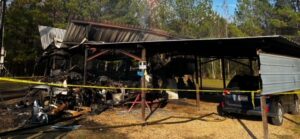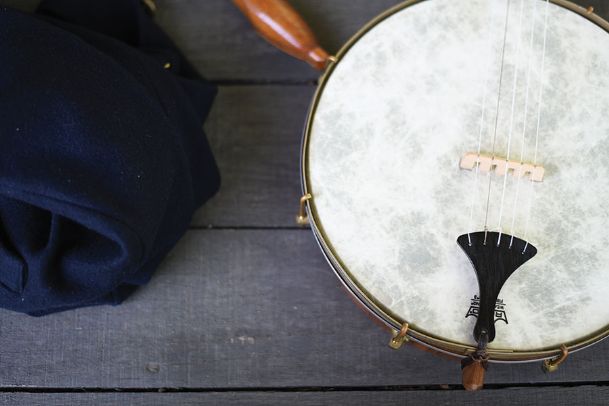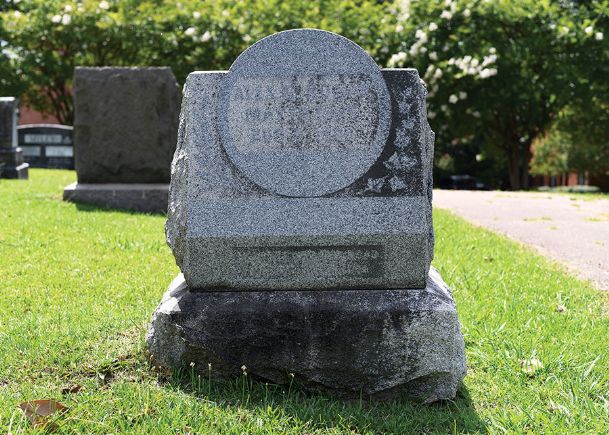On a hot summer’s day, William Pat Arinder sat outside a log cabin built in 1838, frailing “Oh! Susanna” on an 1850s banjo. He wore a buttoned-up wool Confederate jacket, faded grey with red detailing at the collar and sleeves, designed for a lanky artillery soldier, with tall leather riding boots and a brown hat embellished with a gold ‘C’ on the side.
A vest from a Union uniform laid on the porch nearby.
Arinder looked like a soldier straight from a Civil War tintype, but it wasn’t the 1860s. It wasn’t even the 19th century. It was Friday, and Arinder strummed his banjo outside a preserved log cabin at Amory Regional Museum, surrounded by stop signs, moving cars and modern-day houses. Arinder seemed implanted in a spot hundreds of years ahead of him.
Arinder, 73, is a Civil War re-enactor, teacher and self-made historian, who plays popular campfire songs of the time on a period banjo he bought on Ebay for about $500.
He started participating in battle re-enactments in the early 1990s and noticed that no one was playing music off the battlefield, beyond the fife, drum and bugle. Music soldiers would play around the campfire at night — with banjos, spoons or bones, harmonicas and fiddles — was left out of the picture. So Arinder bought his banjo and a bunch of Civil War songbooks and found his chosen role, at a crossroads between his lifelong passions for music and history.
“When I would go, I would sit around the camps playing music, and it turned into what my thing was,” Arinder said.
The banjo he strums in Union and Confederate camps is far different than the first banjo he played, the one he made in 2008, featuring a piece of wood carved into a round head with a swatch of artificial skin placed in the center. He called the process, which totaled 40 hours over one month, “pretty easy,” although one look at the 1970s Foxfire Series diagrams he used as reference would tell you otherwise.
“These are called mountain banjos, because they were made by hand by folks back in the Appalachian Mountains that could not afford a factory-made banjo,” Arinder said.
Right when he picked up the banjo, it just came naturally, Arinder said. He didn’t have the same way with the trombone, guitar, harmonica, fiddle, mandolin or mountain dulcimer that he tried to master earlier in his life.
“The banjo is really my instrument,” Arinder said. “It just fits, that’s all. … I never was able to master the fiddle.”
When he unpacks his instrument from its black coffin case and plays — after instructing those around him to keep the beat for him with a pair of wooden spoons — that talent is obvious. He knows his craft, and he’ll explain how Civil War banjos didn’t have frets — metal strips along the fingerboard — and how musicians strummed them by a style called “clawhammer.” Then he’ll pluck his banjo and sing tunes from his Stephen Foster set, which includes “Camptown Races,” “Beautiful Dreamer” and “Old Folks at Home,” without a hitch.
Arinder has come to appreciate music’s role in the common soldier’s experience — one that dates back long before even the Revolutionary War. The “singing, cutting up and dancing” was relief from fear and anguish soldiers experienced, regardless of their side.
“It was a relief from the stress of being away from home, being lonesome, fear of being killed or wounded,” Arinder said.
History of music on the battlefield
In early American wars, including the Revolutionary War, the War of 1812 and the Civil War, music was the primary medium for an important job on the battlefield: communication, said Jim Woodrick, deputy state historic preservation officer for the Mississippi Department of Archives and History.
Drum and bugle patterns would inform troops to change direction and formation above the loud soundtrack of battle, when voice commands wouldn’t suffice.
Communication was the primary purpose of having musicians in the ranks, Woodrick said, but bolstering morale was a secondary objective of wartime music men.
“They were there to inspire the troops,” Woodrick said.
When musicians weren’t playing, they would serve in other roles, such as hospital stewards. But as the war went on, bands quieted down while musicians were tapped as additional troops, Woodrick said.
In the 21st century, communication by drum and bugle isn’t necessary, making music’s place in the military far more ceremonial.
“Now we have telephones and radios and all of that good stuff,” Woodrick said.
Music in combat isn’t entirely obsolete, though, at least at Columbus Air Force Base.
Most alarms on the base are voice alarms and computerized sounds, which are far more efficient than a drummer or bugler parading the grounds. However, in the case of an imminent attack, American history would come into play. A recording of the bugle call “To Arms” would warn airmen the same way it’s riled up soldiers for centuries, according to Senior Airman Beaux Hebert with CAFB’s public affairs office.
Furthermore, bugle songs, although not played live, are still part of everyday operations on the base.
Each duty day starts with morning bugle calls over the loudspeakers. At 7 a.m., the flags are raised with “Reveille,” written in 1812 as “Troop” for roll call, followed by “To the Colors,” Hebert said.
At the end of the work day, “Retreat” sounds throughout the base followed by the national anthem at 5 p.m. Quiet time on base begins at 9 p.m., when “Taps” is played.
The songs are played to honor the nation and “pay respect to what (the flag) stands for,” Hebert said. The calls are a preservation of history.
A real-life war musician
At least one man who lived in the Golden Triangle area played the war-musician part in real life. Alexander Green Hogan, of Starkville, served as a musician for the Confederate Army.
Born in Huntsville, Alabama in 1829, Hogan moved to Starkville as a young boy with his parents, Elijah Hogan and Mary Lampkin Hogan.
Hogan was a member of the Lowndes Riflemen, Company B of the 43rd Mississippi Infantry regiment. After enlisting, Hogan transferred rank from private to musician on May 1, 1862, in Columbus, according to records within the Ames and Hogan families’ papers housed at Mississippi State University’s Mitchell Memorial Library.
The collection documents the families’ histories from 1816 to 1910 and contains receipts, letters, speeches, and miscellaneous documents and items.
It’s unclear what instrument Hogan played.
After the Siege of Vicksburg, which ended July 4, 1863, Hogan surrendered as a prisoner of war to Gen. Ulysses S. Grant, according to records within the collection’s third folder.
Hogan was released and captured again later in the war near Nashville, Tennessee, on Dec. 15, 1864, according to the records.
At the precipice of the Civil War, Hogan was listed as a merchant in Oktibbeha County Census records in 1860, and later a “Dry Goods Merchant” in 1880 census records. He was listed as a farmer in the 1900 census.
Hogan died on Aug. 6, 1905 at age 76. He’s buried at the Odd Fellows Cemetery in Starkville with other members of the Hogan family.
Preventing the mistakes of the past
After retiring from careers in banking and insurance, Arinder is free to do what he really likes — yes, dressing up and playing the banjo for re-enactments several times a year, to keep a somewhat “overlooked” part of history alive.
“Around here when you go to re-enactment, everybody wants to be Confederate,” Arinder said, laughing. “They have a hard time finding anybody to be Union. … You’ll have 100 Confederates and 10 Union folks, and so I usually go Union because they can’t get anybody else to do it.”
Arinder had 12 ancestors fight in the Civil War — 11 for the Confederacy, and one for the Union, so he especially doesn’t mind playing for both teams.
“I guess it’s kind of in my genes that I just loved history,” Arinder said.
Arinder also pulls out the wool vests and pants and leather boots to teach history programs in area schools, churches, civic centers and museums through the Natchez Trace Parkway.
He said he has always tried to incorporate music into his programs, about prehistoric Native Americans, early pioneer settlers and music during the Civil War, because he simply enjoys music and understands it as “a universal language” that “was important to our ancestors, too.”
However, he thinks it’s most important to study and teach about history to prevent, or attempt to prevent, mistakes from recurring. He said he doesn’t glamorize war in his lessons.
“If people could sit down and talk things out, a lot of it could be avoided,” Arinder said.
You can help your community
Quality, in-depth journalism is essential to a healthy community. The Dispatch brings you the most complete reporting and insightful commentary in the Golden Triangle, but we need your help to continue our efforts. In the past week, our reporters have posted 51 articles to cdispatch.com. Please consider subscribing to our website for only $2.30 per week to help support local journalism and our community.







